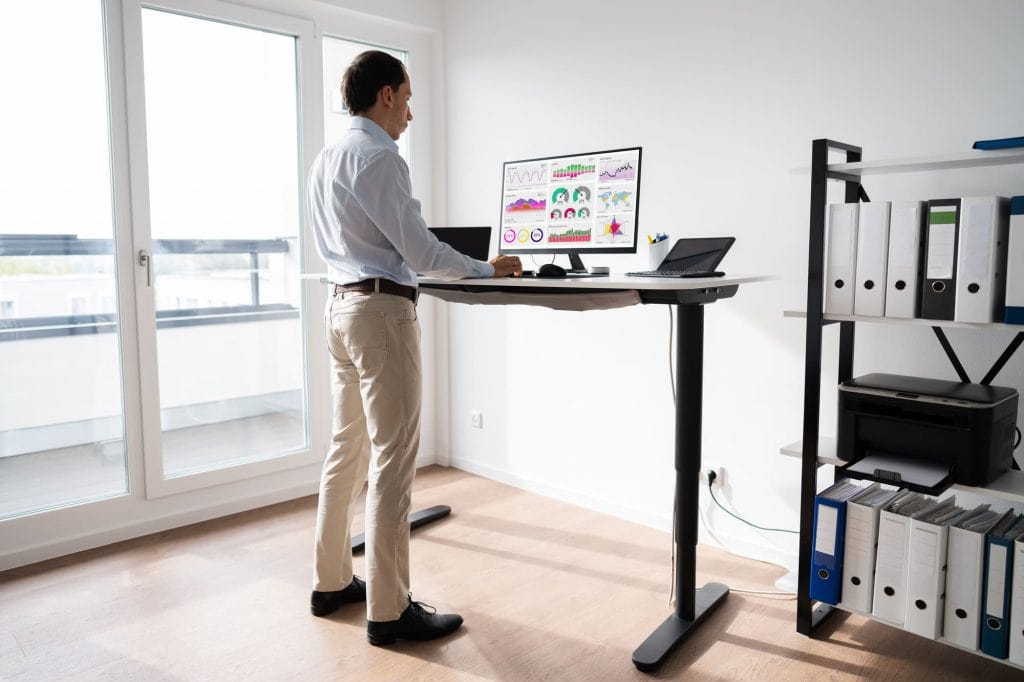*When you buy through links on our site, we may earn an affiliate commission at no additional cost to you.
As you already know, a sedentary lifestyle has been scientifically proven to cause many health risks. You’re encouraged to try and avoid prolonged sitting in your office chair when working from home or at your office job.
Standing desks present a good solution to avoid sitting for prolonged hours. They force you to get off your butt—minimizing the number of hours you spend sitting, helping you burn calories, and increasing your productivity.
However, the best standing desk, especially an electric model, can get pricey. And you may not have enough money to get one. And this brings us to the question: Can a standing desk be covered by insurance?
Keep reading for more in-depth details…
Table of Contents
Can standing desks be covered by health insurance?
The answer is a resounding YES! Your insurance can pay for your sit-stand desks. But you need to meet a few requirements to enjoy this offer. Let’s discuss the main conditions that will easily qualify you to have your standing desk covered by your insurance.
A medical condition
Do you have a specific medical condition that makes a standing desk convenient office furniture? If yes, you have a high chance of having your insurance pay for your standing desk.
For those who may not know, the ADA (United States Americans with Diabetes Act (ADA) clearly states that it’s illegal to discriminate against people with disability in various areas of life, including in the employment sector.
If you get qualified for a job and are disabled, your employer MUST provide reasonable accommodation for your disability.
In other words, your employer can cater to any requests you make that will help improve your work environment. But this doesn’t mean going overboard and asking for things the company may not be in a position to provide or afford.
With this in mind, having a condition that requires working while working may help you present a strong case that makes you eligible for a standing desk by the insurance.
Several conditions may qualify you to benefit from the use of a standing desk. Examples include cervicogenic headaches (which may occur on one side of your neck, head, or face), back pain, neck pain, poor circulation, joint pain, discogenic pain, and high blood pressure.

Sitting on your office chair all day can worsen these, making stand-up desks a good solution to help alleviate the pain and/or even lessen the symptoms associated with the conditions. This way, the employee can fully focus on their work.
What’s more, you’ll enjoy additional benefits of using a standing desk, such as minimizing the risk of weight gain, enhancing your mood, lowering the risk of cardiovascular diseases, and even enhancing your productivity!
The doctor’s standing desk prescription
Your chances of having your desk covered by your insurance can significantly increase if you get a note for the standing desk from your doctor. This is usually referred to as a letter of medical necessity.
So, if you’re asking yourself, “Can you get a prescription for a standing desk?”…
Yes, you can get your medical doctor to give you a note for this type of office furniture.
But how exactly do you get a doctor’s note for your standing desk?
The process isn’t as hard as you may be thinking. You simply need to write down your job requirements and the tasks you usually do at work. Share this info with a medical doctor.
They will carefully go through it and compare it with your disability or existing condition. He’ll give you a prescription for a standing desk!
NOTE: Besides a doctor, if you have a chiropractor helping with your back or posture issue, you can also get a standing desk purchase recommendation from them. Take full advantage of this opportunity and have them write a note that you can present to your insurer. Physical therapists and registered nurses are also qualified to prescribe a standing desk.
HSA vs FSA funds for buying a standing desk
At this point, you’ve probably obtained a doctor’s prescription for a standing desk, so what’s next? You just need to decide whether to use an HSA (Health Savings Account) or FSA (Flexible Spending Account) to get the standing desk.
Generally, the health insurance offered by your employer has both HSA and FSA accounts to let you pay for your insurance and access your funds.
One option may be more convenient for you to purchase a new standing desk than the other. Plus, determining whether a standing desk is eligible may vary depending on your account option.
For starters, this is what the two plans are all about:
Health Savings Account
HSA refers to a type of savings account where you can set aside money on a pre-tax basis to help pay for all your qualified medical expenses.
Note that you can only contribute funds to this health insurance plan if you’ve got a high deductible health plan. But the good news is that you can pull out your funds anytime.
(Note that if your employer offers a high-deductible health plan, it’s even easier to claim a sit-to-stand desk).

If you want to have your standing desk to be paid for by this insurance plan, you’ll need to send a purchase receipt plus a fully complete claim report to the insurer. You may also be required to send additional applications depending on your insurance company.
The period it takes to know if your claim has been approved is around one month, so you need to be patient with this process.
Flexible Spending Account
FSA plan is usually established through your employer and is 100% tax-free. This health plan enables you to cover out-of-pocket medical expenses, including the insurance deductibles.
Your employer is responsible for setting a limit on how much you can contrite to your FSA account. Then, you can go ahead and decide how much you want to put in your Flexible Savings Account.
Now, for your desk to be covered by FSA, you’ll need a doctor’s prescription. Considering that a standing desk falls under the class of ergonomic items, you’ll most likely get approved for this insurance cover if you provide proof of a condition/need.
We advise you to buy the standing desk and then submit the receipt and claim form to your company. You’ll also need to submit a form explaining the benefits of standup desks and the doctor’s note (i.e., a letter of medical necessity).
This would be an easier path for you because the debit card offered for FSA plan is only usable at specific, approved establishments. You may not easily find an ideal standup desk in these establishments.
When not to have your insurance pay for a sit-stand desk
Having your office furniture covered by your insurance can be a huge relief. However, it may not always be a good idea to go down this path.
We advise you to take your time to decide if you’re indeed making the right decision.
Timing is important
To start with, you want to decide when is the right time to use your insurance for a standing desk.
Check with your insurance provider on when your account will roll over. Or if you’re needed to use the balance within a year.
If they say that it is about to roll over, that’s the perfect time to purchase a standing desk because you’ll lose the money inside.
Consider other medical expenses
You may find yourself at crossroads wondering whether to use your tax-free funds to buy a standing desk or cater to your medical expenses.

A standing desk may be less essential than any other medical expenses you may have for the year.
If you’re diabetic, for instance, you may also want to rethink using the medical insurance money on a sit-stand desk.
This is because you’ll be deducting insulin expenses and would like to limit other purchases covered by the insurer.
Get your HR department to buy standing desks
You may also get lucky enough to have your company purchase the sit/stand desks for you. This is especially true in companies that appreciate this office innovation and are mindful of their employees’ health benefits.
The employees may take the first step and write to or approach the human resources department and request sit or stand desks. You must explain the effect standing desk units can have both on your health and the overall outcome of the business.
Some employers even have a standing desk policy in place. Check the employee handbook for any ergonomic resources or wellness programs. This means you don’t have to use your own funds from your medical cover to invest in a standing desk.
Still, at it, a company with over 15 employees who have physical disabilities might request a standing desk from their employees. This will go in line with the ADA act, and your HR may purchase the desk for you.
But remember, the employees will need to submit a letter of medical necessity from their medical doctors to prove that they indeed require a standing desk to improve their working conditions.
Take advantage of remote stipends
As the world embraces the work-from-home idea, a standing desk can become one of the perks you’ll get.
Most employers are willing to pay for home office equipment for their employees working remotely to ensure they have the best working conditions for maximum output.
States like California, Illinois, and Massachusetts even require employers to reimburse for home office expenses!
Check if your future employer offers remote work allowance, stipend, or remote employee reimbursement. If they do, there are high chances your standing desk is covered.
Final Thoughts
Standing desks can get costly depending on the model you settle for. If you’re struggling to purchase a stand-up desk, the good news is that you can have your insurance pay for it.
Health insurance is meant to help you cater for things that help you manage your health, and a standing desk is no exception.
As discussed in this guide, you can go with FSA or HSA insurance plan to pay for your standing desk.
The process is relatively simple regardless of which plan you use. Most insurance providers will reimburse you if you have a doctor’s note or letter of medical necessity!
We advise you to weigh your options before using your FSA or HAS funds to purchase a standing desk.
Compare a sanding desk vs. other medical expenses you may have to help you decide which one will be a priority for this tax-free money.



